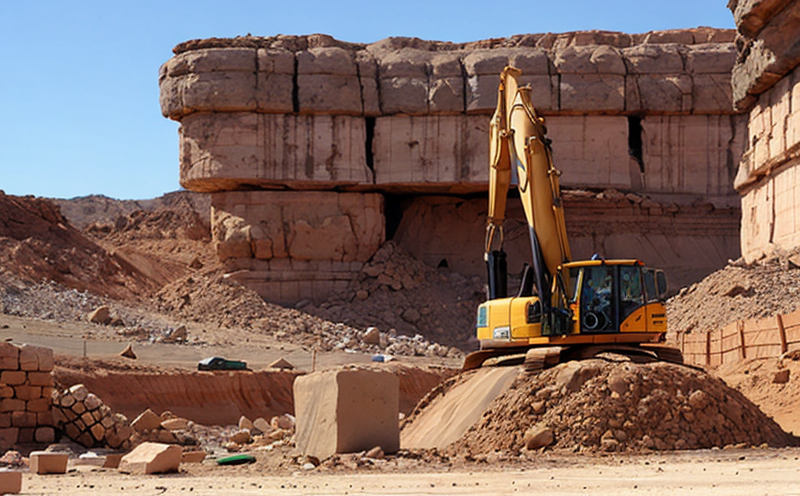ASTM D3148 Elastic Moduli of Rock in Uniaxial Compression Testing
The ASTM D3148 standard provides a method to determine the elastic moduli of rock samples under uniaxial compression. This testing is critical for understanding the mechanical behavior of rocks in mining applications, particularly those involving underground excavations such as tunnels, mineshafts, and shafts. The test helps predict the stability and safety of these structures by assessing how rocks deform elastically under stress.
The process involves subjecting a cylindrical rock specimen to uniaxial compression until it reaches failure. During this test, instruments measure the applied load and corresponding displacement. From these data points, engineers can calculate the elastic modulus (modulus of elasticity) which reflects the material's stiffness or resistance to deformation under stress.
This testing is pivotal in several ways:
- Structural Integrity: By knowing how rocks behave under compression, mining operations can design safer and more stable structures.
- Risk Management: It aids in identifying weak zones within rock formations to avoid potential failures during excavation or drilling operations.
- Material Selection: Engineers use these tests to select appropriate materials for lining underground facilities like tunnels where the surrounding rock might not provide sufficient support on its own.
The methodology is detailed in ASTM D3148, which specifies precise procedures for sample preparation and testing. Specimens must be cylindrical, free from fractures or flaws, and representative of the rock's properties. The test setup includes a hydraulic press capable of applying controlled loads to the specimen while monitoring strain.
Understanding elastic modulus is crucial because it influences the design and construction processes significantly:
- Tunnel Design: Higher elastic moduli indicate stronger rocks, which can support larger tunnels with fewer reinforcements.
- Mine Planning: Knowing a rock's elastic properties helps in planning more efficient extraction methods without causing structural damage to nearby areas.
The testing process is not only about determining the modulus but also about ensuring that the test conditions replicate real-world scenarios as closely as possible. This ensures that the results are applicable and reliable for various mining applications.
| Sample Preparation | Test Setup | Data Collection |
|---|---|---|
| - Specimens must be free from defects - Diameter should match specified limits - Length-to-diameter ratio controlled within certain ranges |
- Hydraulic press with precise load application - Strain gauges for displacement measurement - Load cell to monitor applied force |
- Continuous monitoring of stress and strain - Recording peak load before failure - Analysis of deformation behavior under load |
The results from ASTM D3148 are essential inputs in the design phase, helping engineers make informed decisions about structural integrity. The data provides insights into how different types of rock behave under stress, enabling more accurate predictions and safer designs.
Benefits
Implementing ASTM D3148 elastic moduli testing offers numerous benefits to the mining industry:
- Safety Enhancement: By understanding rock behavior under stress, potential failures can be anticipated and mitigated.
- Economic Efficiency: Properly designed structures reduce maintenance costs and extend operational lifetimes of tunnels and mines.
- Innovation Support: Engineers can develop new techniques for rock excavation that minimize environmental impact while maintaining safety standards.
- Precision in Planning: Accurate elastic modulus data helps planners allocate resources more effectively, ensuring better project outcomes.
The test results are valuable not only for existing infrastructure but also for future projects. They contribute to the continuous improvement of mining practices and technologies, ultimately leading to safer and more sustainable operations.
Industry Applications
| Application Area | Description |
|---|---|
| Tunnel Construction | Evaluating the stability of tunnel walls and identifying weak points in rock formations. |
| Mine Design | Determining appropriate dimensions for mine shafts based on rock elasticity to ensure structural integrity. |
| Underground Facility Lining | Selecting suitable materials for lining tunnels and mineshafts that provide adequate support. |
| Risk Assessment | Identifying areas prone to instability or collapse due to poor rock properties. |
| Extraction Method Optimization | Evaluating the impact of different extraction methods on surrounding rock stability. |
| Maintenance Planning | Assessing the durability and remaining life expectancy of mining structures for timely maintenance planning. |
| New Technology Development | Providing data necessary for developing innovative excavation techniques that enhance safety and efficiency. |
The application of ASTM D3148 in these areas ensures the continuous improvement of mining practices, leading to safer operations and more sustainable projects. This testing method is a cornerstone of modern mining engineering, providing essential data for critical decision-making processes.
International Acceptance and Recognition
The ASTM D3148 standard has gained widespread recognition and acceptance in the international community, particularly within the mining sector. Its adoption by regulatory bodies worldwide underscores its reliability and relevance:
- Australia: The Australian Centre for Geomechanics recognizes ASTM D3148 as a key standard for rock mechanics testing.
- New Zealand: Standards New Zealand incorporates the methodology into their national standards for underground mining safety.
- United Kingdom: The British Standards Institution (BSI) acknowledges the test as essential in the design of tunnel and shaft structures.
- European Union: European standards bodies, including CEN and CENELEC, reference ASTM D3148 for rock mechanics testing across member states.
The standard's international acceptance is further bolstered by its alignment with global safety regulations. For instance, the International Labour Organization (ILO) recommends the use of such standards to ensure occupational health and safety in mining environments.
Given this widespread recognition, ASTM D3148 has become an indispensable tool for quality managers, compliance officers, R&D engineers, and procurement specialists involved in mining operations. Its consistent application across different jurisdictions ensures uniformity and reliability in testing results, which is crucial for the global mining industry.





